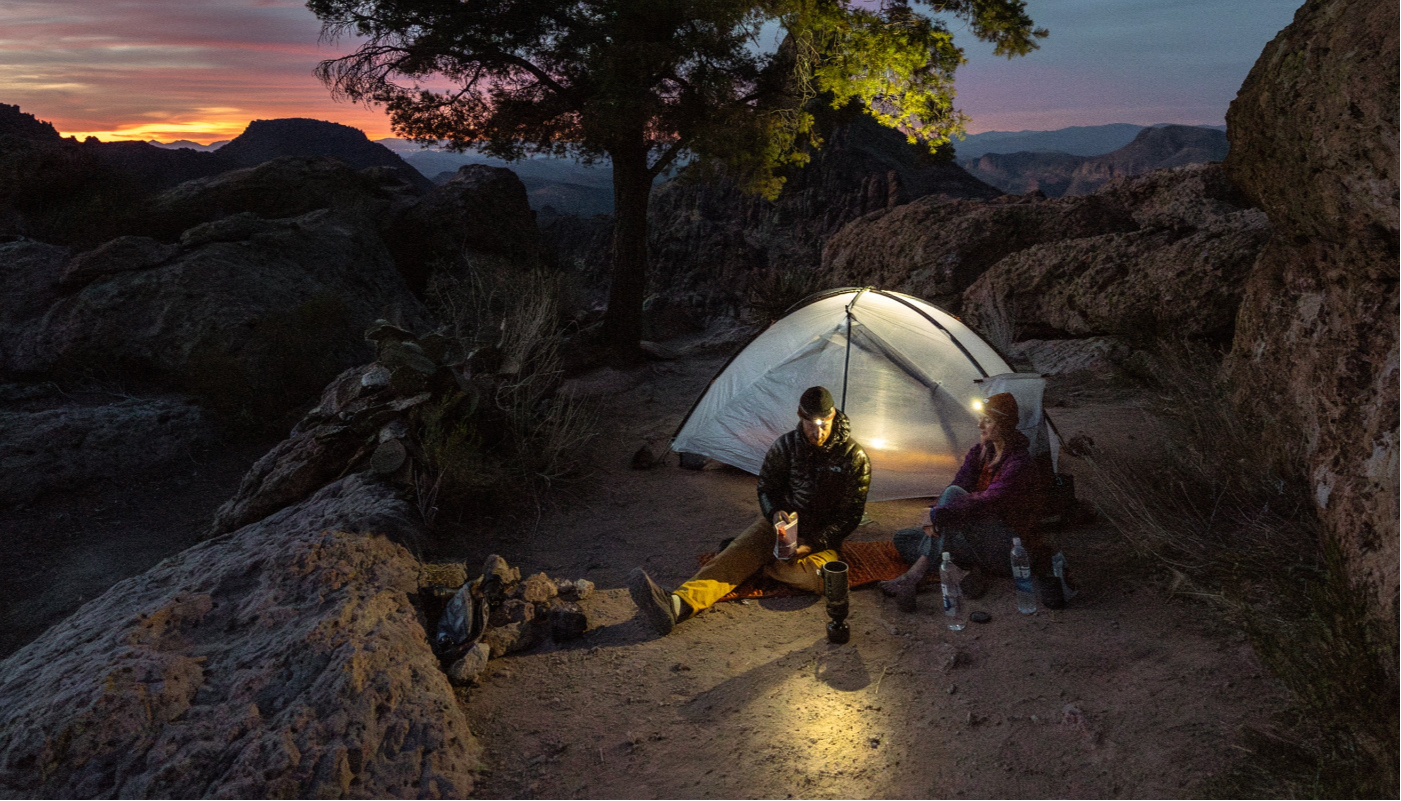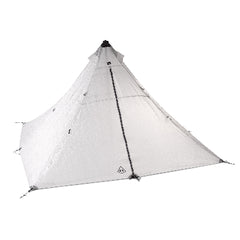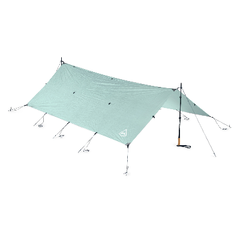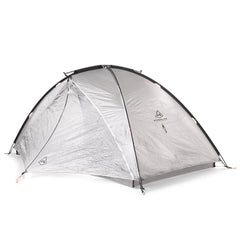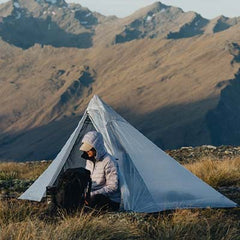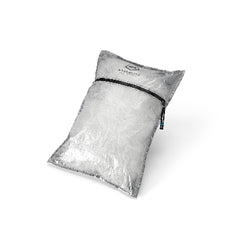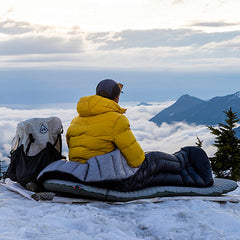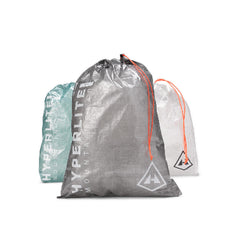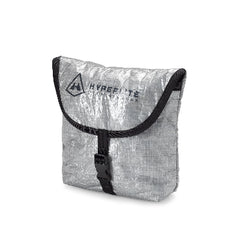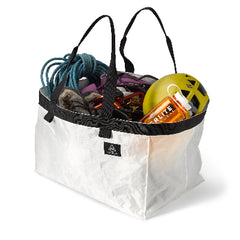It doesn’t matter how beautiful the scenery is around me. The reality is that I am scared, in over my head, and want to quit.
Looking up I see that the sun is slowly fading behind increasing, ominous-looking clouds. I am absolutely drenched in sweat, my teal sun hoodie soaking with the effects of my effort. My blue Yosemite hat is covered in white patches of bug spray, but provides me no defense against the black flies constantly swirling around my body and nipping at my ears. Every part of me hurts and wants just one simple thing: to stop moving. My toes are in pain, in particular my right big toe after two miles of jamming into the front of my shoe while sliding down slippery rocks. The outside of my right knee is flaring up again, making the most natural human movement of bending my knee to move forward feel laborious. My shoulders ache from carrying my pack, which feels like it is being filled with rock with each passing step. My face is so sweaty that my “no slide” sunglasses keep sliding right off.
Surrounded by pine trees wafting the comforting sense of Christmas towards me, I stop. The mountain’s enormity begins to overwhelm me. Here I am, this infinitely small speck plopped on the side of an ancient mountain that, millions of years ago, was as tall as the Himalayas. This thing has existed long before I was born and will continue to persevere long after I am gone. In the timescale of this mountain, I am nothing. Barely a blink. I am just a tiny, quivering mammal who is hungry, thirsty, in pain, and completely lacking control in this situation.
I stop and try to gather myself. The wind begins to howl, almost blowing the hat right off my head and over the ledge that leads into the abyss. Troy is about two minutes behind me, meaning I have just enough time to center myself and try my best to hide my serious doubts about what we are doing. I realize that the section we just went through on this hike would be really sketchy to try and retrace if we wanted to bail. The rock is too steep and too slippery. The clouds thicken and the wind strengthens, as if to remind me once more of how little control I have in this situation. I am miles from civilization and cell service. It occurs to me that we haven’t seen anyone else on this isolated trail. We are alone. I have just enough food to last an expedition that goes perfectly, but nothing extra for even a less-than-perfect-case scenario. Same goes with the water that sits in my overheated rubber bladder with a chewed up, slightly moldy hose to drink through. I hang my head with the realization that there is no other option:
We must continue forward.
And why am I here, anyway? There is no box to check with this hike. No sticker to put on the car or button to put on the bulletin board. No glory, no triumph. Just the experience itself.
I sigh and continue forward, hoping that the lack of any achievement whatsoever will be worth it in the end.
—
I am fortunate to live just outside Adirondack Park in Upstate New York. Larger than Glacier, Yosemite, Grand Canyon, and Yellowstone National Parks combined, the Adirondack Park takes up almost 20% of New York State and is one of America’s first great conservation victories. A unique combination of public and private land, our state constitution designates the area as “Forever Wild”. Meaning that this rugged, brutal, awe-inspiring landscape will remain that way for myself, my children, and my grandchildren. It is a phenomenal luxury to think that, if I shut my laptop right now, in just 45 minutes I could be at the trailhead of a spectacular mountain or diving into a pristine lake surrounded by majestic wilderness.
Living around here, it is impossible to talk about hiking without hearing about “The 46”. This term refers to the 46 High Peaks in the Adirondacks, which are the mountains that are over 4,000 feet in elevation (Mount Marcy being the highest at 5,343 ft). Around these parts it is a great honor to be designated as a “46er”: someone who has summited all 46 of the High Peaks. For some people the challenge takes an entire lifetime. For others, they burn through it rather quickly in a few years. A select few have summited all 46 high peaks multiple times throughout their life.
Over the past couple of decades membership in the 46er club has exploded. More folks than ever are getting out and completing the list, which has its upsides. The more that people are getting outside, moving, and learning to love nature, the better it is for both the individual and society as a whole. In a culture suffering from Nature Deficit Disorder, more people spending more time in nature is good for everyone’s health and overall wellness. It is hard to love what you do not know. And it is hard to protect that which you do not love. So, hopefully, this increase in interest is helping others get to know the wilderness, grow to love it, and become inspired to protect it.
That’s the hope, at least. The reality is a bit more nuanced. Ironically, this increase in attendance is coming at a cost. A sudden burst in interest has put great strain on both the infrastructure and ecosystem of the isolated High Peaks Wilderness. Trails are becoming overtrodden, waste and pollution are increasing, and local agencies are struggling to manage the huge influx of hikers on delicate landscapes.
Recently, on the summit of a small peak I hiked with my wife, we began chatting with an older couple (Scott and Caroline ) who became 46ers back in the 80s. When I asked Caroline thoughts were on the increase in interest, she responded with a story:
A tropical storm had recently passed through, and many of the trails in the High Peaks Wilderness were flooded, muddy, and vulnerable. Apparently, local agencies were pleading with people to stay off the trails over the weekend in order to protect them. Just one weekend, social media posts read, and we can get back to enjoying summer in the Adirondacks. The pleas, though, went unheeded. According to Caroline, parking lots remained overstuffed, cars continued to park on narrow country road shoulders, and attendance, while lower, was still enough to be damaging.
“It is almost as if people care more about themselves, their ego, and their accomplishment than they do the landscape where they are accomplishing whatever it is they set out to do” she said with an air of resignation and hint of frustration. In other words, the checkbox, the completion, the to-do list for many people is becoming a greater priority than the actual environment they are experiencing. It’s not about the adventure; it’s about the status that comes with it.
Naturally, as someone who loves hiking and lives so close to the peaks, the 46 are always on my mind. Just a few weeks ago, at a doctor’s appointment, the nurse who was checking my vitals asked what I like to do for fun. I mentioned my love of hiking and detailed some of the plans I had for the summer. Immediately, she perked up and asked:
“Oh! Are you trying to become a 46er?”
My answer was what it has always been:
Absolutely not.
It is not that I don’t think it is an impressive accomplishment, or that I don’t think I can do it, or that I’m not interested. In actuality, I admire anyone who has the fortitude and dedication to complete the feat. I’m thrilled that the mystique of the “46” is getting more people outdoors and enjoying themselves in nature. I am interested in doing it, and have thought about attempting it for years.
My issue does not lie in a lack of ability or fortitude.
It lies in my mental predispositions.
I am a perfectionist. A completionist. A “to-doer”. Give me a list of things that need to get done and I will check all of those boxes like they have never been checked before. And I won’t rest until they are all done.
Completing the 46, like the Seven Summits (even of your neighborhood), or the highest peak in each state, is at its core a to-do list. A checkbox. An accomplishment that results in patches on backpacks, buttons on duffel bags, stickers on water bottles or car windows.
This is my jam. I love completing lists. So why not become a 46er and complete the ultimate adventure to-do list in the Northeast?
—
The purpose of adventure, in my humble opinion, is to inspire change in the self. To push our limits, challenge our predispositions, and allow a piece of ourselves to die in a rugged landscape so that we can be reborn with a greater sense of beauty, purpose, and serenity.
Lately, though, it feels like that is becoming less and less the case.
Scroll social media and we see an endless stream of epic peaks, outrageous landscapes, and incredible viewpoints. We see adventure being turned into commodity, the goal being to get to the spot we see online so we too can snap the picture and move on. We engross ourselves in the incredible feats of strength of rugged adventurers and feel we need to mirror those experiences if we too are to have a great adventure. We put together a bucket list of places we want to see and things we want to do. Nature becomes a background for our own egoic exploits. It becomes something to “do”, to “conquer”, instead of something to experience and marvel at.
The flaw in this thinking is that nature cannot be conquered. Mountains are not meant to be “checked off” or used as like-bait. The mountain doesn’t care about us, whether we are there or not, whether we live or die on its body. It exists as it is, and we can only experience what it is willing to give us on a day-to-day basis.
If seeing the Dolomites, Horseshoe Bend, or the top of Half Dome inspires you to get outside and explore the world, that’s great. I’m all for it to a point. But if the purpose behind those expeditions becomes to check the box, or to get the shot, or to satisfy some insecurity churning within, then the adventure loses its power. It becomes less about the internal change that it can create and more about the external validation of having done something admirable. Nature has an immense power to heal and inspire, but only if we appreciate it for what it is and allow it to teach us its quiet, subtle lessons. Sure, many lessons can be learned in glorious landscapes. I've been the recipient of quite a few in those locales. But if we only focus on bagging peaks and completing lists, then we miss out on all the other incredible places that can be just as, if not more, impactful on our lives. A lesser-known patch of homogeneous forest, when traversed mindfully, can offer a much richer experience than a rugged, dangerous peak summited egotistically.
This is where the culture of peak-bagging, box checking, and Glam for the ‘Gram falls short of being meaningful in my eyes. If we are only after an accomplishment then nature becomes nothing more than the background for a task that we have deemed as more important. It lends us to focusing more on time, elevation, and completion as opposed to observation and appreciation. It can often result in missing out on perfectly beautiful and meaningful landscapes simply because they do not have a title attached to them. Why saunter through a beautiful forest to sleep by a placid lake if the time and energy could be spent working towards finishing off that list? Why hike the same mountain twice, when the calories can be burned in pursuit of the next one? It’s done. It’s over. There’s no purpose in doing it all again. I have met many people with this exact sentiment, and it makes me think of a simple question:
If you are currently trying to complete your own hiking-based list, how would you feel if you failed?
What if you got halfway up and couldn’t get to the summit? Would you still be satisfied? Would you have a good time? Would you do the same thing again just for fun? Or would there be a gnawing sense of incompleteness?
I know, for me at least, I would feel unsatisfied and frustrated. I would continue to reattempt, each time becoming more concerned about the relief of having done it than the enjoyment of actually doing it.
That’s not why I want to be in nature. And so I prevent myself from even beginning. I don’t want my ego to get in the way of my soul.
I don't want to feel this way, which is why I wanted a challenge to shatter that mindset. I needed to find a lesser-known location that could force me to be mindful and enjoy the experience for what it is, not what it means to the outside world.
—

In the back of a guide book I came across a hike labeled “Only If You Can”. Intrigued, I read about one of the most difficult, rugged, and least-traveled trails in the entire Adirondack Park, one that would put this notion of hiking for its own sake, and not for the titles, to the test. The trail begins by going up Giant Mountain, one of the more difficult High Peaks (when I called a friend who had climbed Giant to ask how it went, his response was brief: “I puked”). From there, the trail descends down Giant, then goes up another High Peak. Most people tend to go up Giant, check the box, and go home. A few others continue onto the second peak, check that box, and turn around. But beyond the second peak the trail continues. In fact, after summiting the two High Peaks, the trail is only about a third of the way complete. Never quite flat, it ascends and descends in a wave, topping off at three more peaks that don’t get the special designation of “High Peak”, with one only missing out by a few feet. It is brutal, the guide states, and should only be completed by “experienced backcountry adventurers” who are capable of “carrying enough food and water to complete the thru-hike.” But, if you can, you will “be rewarded with one of the most spectacular hikes in the entire Adirondacks.”
The idea piqued my interest. Sure, I’d summit two High Peaks that could be added to the list. But what about the rest of the trail? There is no glory that lies beyond those peaks. No stickers. No patches. No real accomplishment of societal value. I would be punishing myself physically for no validation in the end.
Yet, in spite of this, it exists. And it is, allegedly, spectacular.
Not many people go up any High Peaks. Fewer hit two in one day. And I can’t even imagine how many intentionally continue forward, longer than the way they came, with no reward beyond whatever the trail provides solely by existing.
This is not the Appalachian Trail. If you were an experienced thru-hiker, knocking this hike out in a day would probably be a challenging but not unreasonable challenge, maybe with a zero or a nearo afterwards. For me, though, when my hikes are typically short and my wife is expecting me to not pull out the emergency bivvy and unexpectedly sleep in an alpine zone, the numbers were concerning. We all have our limits and comfort zones, and this challenge laid beyond mine. Completing this trail in the time I had available would be a huge push for me, and probably the most difficult thing I would have ever done. It would require going longer, farther, harder than I had ever gone before. It would be brutal, and I knew my comfort-zone would be thoroughly thrashed. And the only satisfaction that would come from it would be that which arose from simply being there, doing the thing, not worrying about results. Pushing myself in the name of seeing what lies beyond what is advertised.
Not all things worth seeing need to be bagged.
Convinced, I called my friend Troy, gaslit his concerns about his bum ankle, and convinced him to meet me before the crack of dawn on a cool Saturday morning.
I was ready to destroy my body in the name of an obscure and seldom-traveled trail.
—

It is a muggy but mercifully cool morning in one of the most beautiful parts of the country. Surrounded by rocky peaks and a pristine lake, Troy and I hoist our bags onto our backs and begin the long journey. I am equal parts excited and nervous. My muscles are limber and strong and I’m full of oatmeal and peanut butter; the perfect recipe for a great hike.
As we begin the ascent the reality of Adirondack hiking hits me immediately. The trail goes straight up, with many parts nothing more than a rock slide with some paint slapped on a few of the fallen boulders as if to say, “Yep, we’re not lying. This is actually the trail.” At no point is the trail flat, a trend that continues throughout the duration of the entire adventure. No switchbacks and no soft landings. Such is hiking in the Northeast.
Hiking up Giant is, as advertised, brutal. Large lunges are required with each leg, making the trek seem like an endless CrossFit workout from hell. There are points where a single slip could send us tumbling down the rockslide - I mean - trail, to a nasty leg injury. And just when we are out of breath and find a small patch of shade for respite, looking up at the gnarly trail ahead takes away any mental comfort that may have come from a much needed break. With each section I think about my friend who hiked this until he hurled and check-in with my stomach. Thankfully I feel fine, at least in that regard. My oatmeal is staying put, for now. I trained extremely hard for this journey, and my functioning digestive system is a sign that the training is paying off.
I have a habit of blacking out and charging forward and breakneck speed as soon as the summit seems within my reach. Not the best strategy when this summit is both difficult and less than a third of the way through the entire journey. But old habits are hard to break. The first summit is, as expected, spectacular. Sweeping views of the Adirondack Great Range surround me, with a cool breeze both cooling me off and keeping the despicable bugs off what little skin I have exposed. Surprisingly, I feel really good. My breath returns quickly, my muscles feel rejuvenated, and we make it to this point in far less time than we predicted.
Coming back down the summit spur, the first bit of reality hits us. We notice the trail junction sign that points towards our destination. The first thing we notice is that the next peak does not follow a slight decline followed by another manageable incline. Instead, we are faced with another about 1,300 feet in elevation change over the next mile. In addition, we see the length of the remaining trail posted on the sign with a number that is, while expected, too high for solace. We are confident in our preparation and feel assured that we can continue. What we are not prepared for, however, is the gnarly descent down.
The time we made going up the first peak is slipping away along a sloggy, grueling descent. Much of the “trail”, such as it is, are wet, angled rocks about ten feet in length each. Each step is precarious, and I slip multiple times. We essentially slide down much of the mountain, scraping our legs and knees on the jagged rocks, because standing is far too precarious and risky. Each of my toes hurt from sliding into the front of my shoes. My knees start to ache from holding my body weight while being fully bent above my chest as I gingerly make my way down and around the obstacles. During a dry spell with grippier rocks maybe this trail would be easier to traverse. But as we mercifully reach the bottom, Troy and I both have a realization:
We probably, really, definitely shouldn’t go back up that.
Is it possible? Sure. Yet there are so many spots that got our heart rates up coming down that going up could result in easier slips, slides, and tumbles that would have larger consequences. While the first side of the mountain was dry and provided plenty of grip, the backside was soaked and treacherous. We have no desire to try and pull ourselves up what feels like ice. This means, for better or for worse, we have to finish this hike. Because, realistically, it is far less risky than going back the way we came if we feel the need to bail.
As we ascend the next peak, I turn a corner and see the Great Range out in the distance. The trail narrows and a gust of wind nearly takes my hat off my head and throws it into the abyss. The massive pine trees sway above me, creaking with each move in their elaborate dance. I am out of breath, sore, and exhausted. I’m already sick of the taste that the Larabars and Honey Stinger waffles provide me; the only food I have on hand.
Troy approaches from behind and takes a rest. He is sweating and downs big gulps of red Gatorade. I pull out a protein bar and begin munching, struggling to find the energy to break apart the chocolate chips with my jaw. Unaware of everything I just experienced, Troy sighs and looks up.
“You good?” he asks with a sense of exhaustion that lets me know that he already knows what I will say, and what the truth actually is.
“Yeah. You?” I ask without looking up.
Troy finishes another gulp of his Gatordade.
“Yeah, I think. This is hard.”
“I know,” I say passively, looking forward on the trail, “and we haven’t even hit the main part yet.”
A moment of silent recognition, followed by packs being hoisted back onto our packs and continuing forward. A friendship forged in suffering.
—

We reach the summit of the second peak after enduring another grueling uphill section consisting of nothing but rocks vomited by the glaciers that left this area thousands of years ago without cleaning up their mess. At the top we take a well earned rest, and the rocks that I lay down on feel more comfortable than any bed I’ve ever owned. In between strong gusts of wind the sun peeks through the clouds and warms me up. After dozing off for a moment, I sit up and replace my hat (which keeps getting blown off my head from the wind) with a sweatband. Troy pulls out his peanut butter and jelly sandwich for lunch. I realize that I have not packed nearly enough and would quite literally kill for the satisfaction of a juicy orange or a chocolate milkshake. Instead, with no opportunities around, I munch on my homemade mix of almonds, blueberries, and dark chocolate. The sugar hits like a drug.
I look out to the Great Range of the Adirondacks, a view that rivals any of the National Parks that I have been to. Looking to the left I see the gradual descent of the mountains into the Champlain Valley, with Lake Champlain beckoning in the distance. What I would give to just jump in the lake and float right now, I think. My gaze lowers from the lake to the trail that stands between us; the inauspicious trail that we are attempting to complete for no real purpose. A rollercoaster of brutal geological forces with a path so overgrown that it is clear not many people, if anyone, has been on it for quite some time.
Discouraged, I think about what I could be missing. If the goal of the day was to march towards our completion of the High Peaks, we could turn around and check two off the list. There are some people who do just this, which is all well and good. I applaud them, because it is freaking hard. If that were us, we would sit here for a long while, enjoy our food, rest up then head back the way we came (mostly descending) knowing that we were halfway done already. This would be done, preferably, in drier conditions in order to decrease the risk on the way back. In that case it would be a tough but very manageable day.
Where we sit now, though, we are roughly one-third of the way through our journey. And the rest is completely unknown and impossible to plan for. There is far more elevation change than if we simply turn around. It is farther than most ever go, as evidenced by the lack of use on the trail. Up to this point, we haven’t seen another person. Challenges aside, it has been an incredible and unique hike. I have to trust that it will continue to be if I am going to get the gumption to actually finish this thing: this alluring trail that, unnoticed, haunts the background of a well-attended High Peak, with no recognition or admiration being sent in its direction.
Beautiful things don’t ask for attention.


